BUS300: Land Securities Performance Report - Stakeholder Analysis
VerifiedAdded on 2022/12/13
|8
|2328
|430
Report
AI Summary
This report provides a comprehensive analysis of Land Securities' performance, evaluating its success from the perspective of its stakeholders. The report delves into both financial and non-financial data, employing a range of performance management tools, including Key Performance Indicators (KPIs), Triple Bottom Line, Ratio Analysis, CSR Pyramid, Competitor Analysis, and the Balanced Scorecard. The analysis includes an examination of financial statements and data, alongside a consideration of non-financial factors such as stakeholder satisfaction and corporate social responsibility. By applying these analytical techniques, the report assesses Land Securities' operational efficiency, profitability, and overall value creation, while also considering its adherence to ethical and legal standards. The study aims to provide a critical evaluation of Land Securities' performance, offering insights into its strengths, weaknesses, and areas for potential improvement. This report is a valuable resource for students seeking to understand the complexities of performance evaluation and strategic management within a real-world business context.
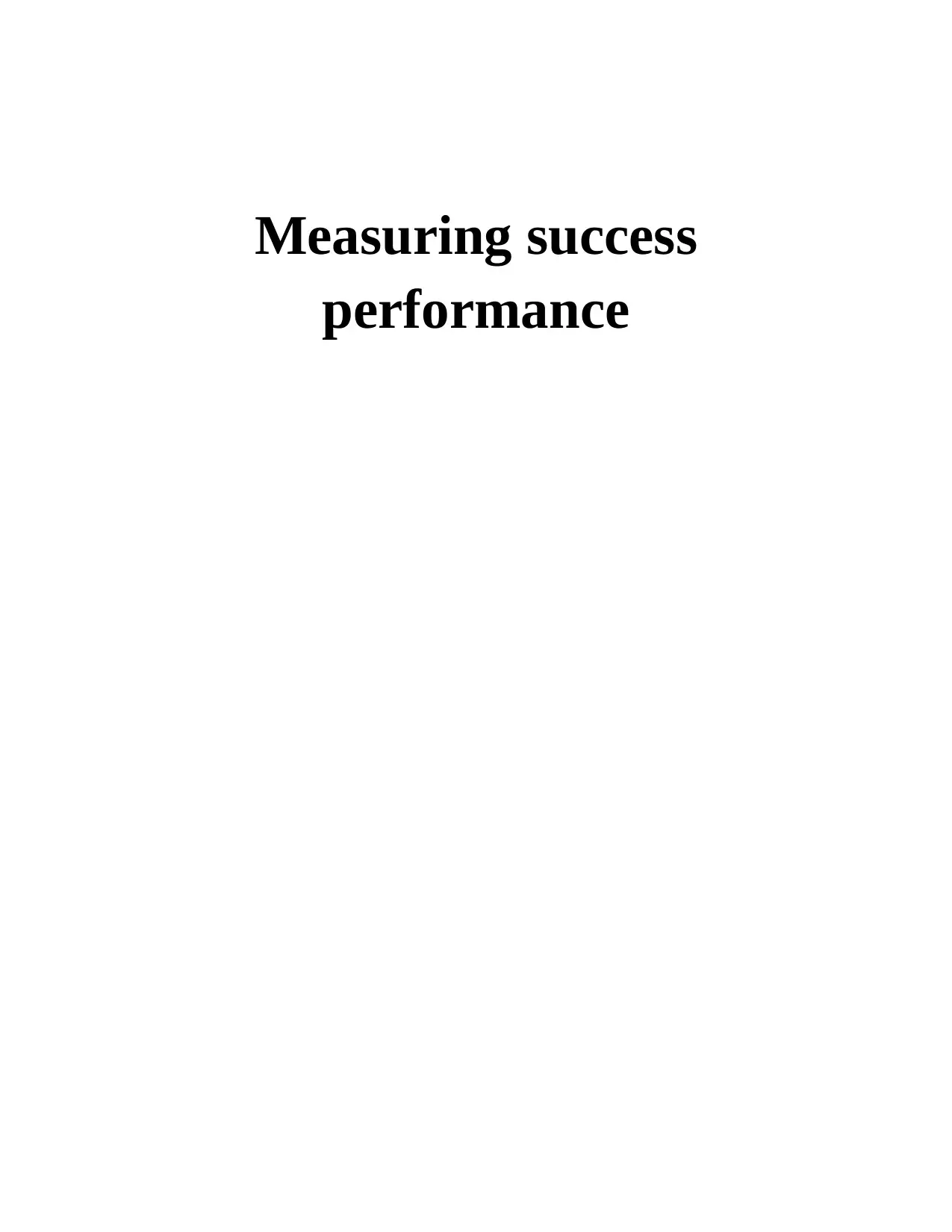
Measuring success
performance
performance
Paraphrase This Document
Need a fresh take? Get an instant paraphrase of this document with our AI Paraphraser
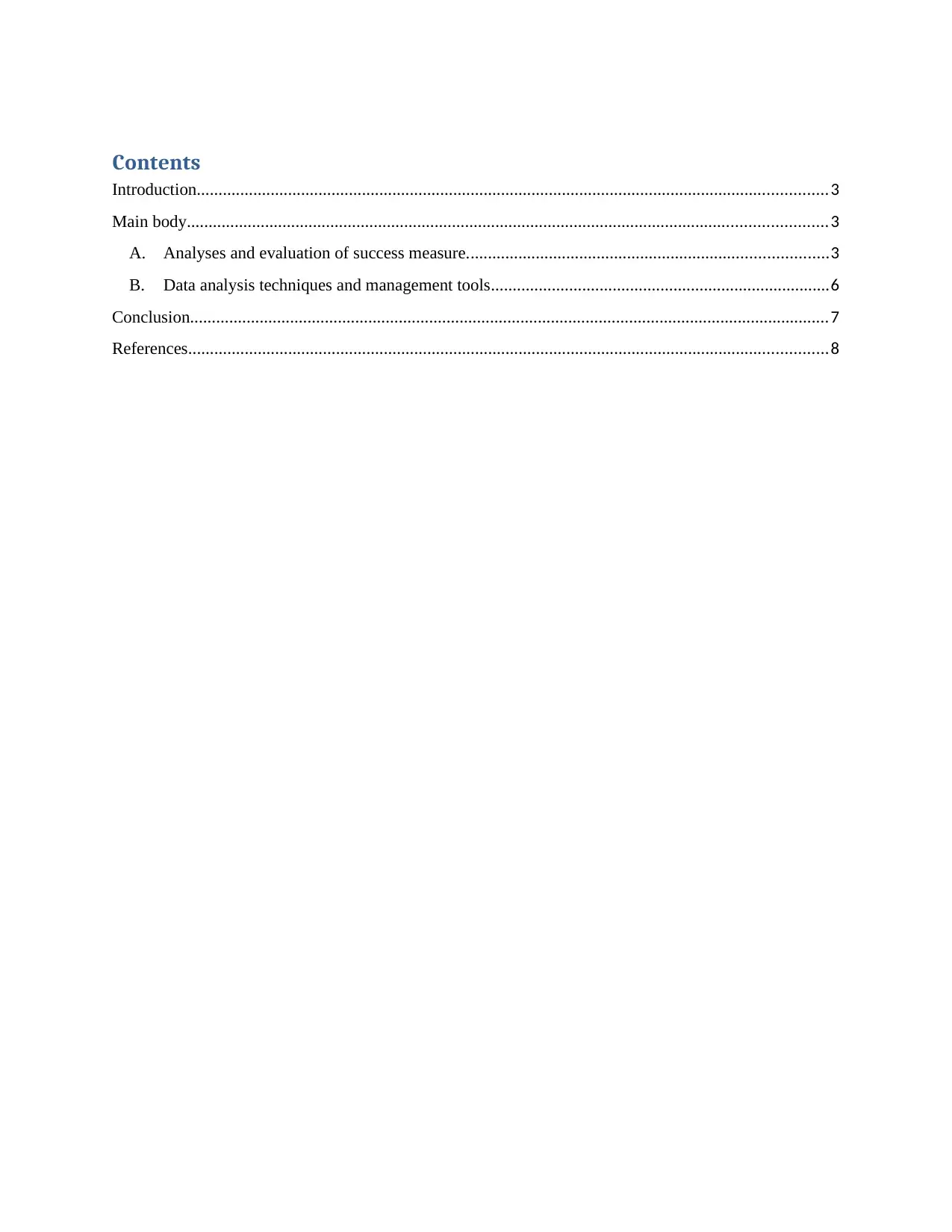
Contents
Introduction.................................................................................................................................................3
Main body...................................................................................................................................................3
A. Analyses and evaluation of success measure...................................................................................3
B. Data analysis techniques and management tools..............................................................................6
Conclusion...................................................................................................................................................7
References...................................................................................................................................................8
Introduction.................................................................................................................................................3
Main body...................................................................................................................................................3
A. Analyses and evaluation of success measure...................................................................................3
B. Data analysis techniques and management tools..............................................................................6
Conclusion...................................................................................................................................................7
References...................................................................................................................................................8
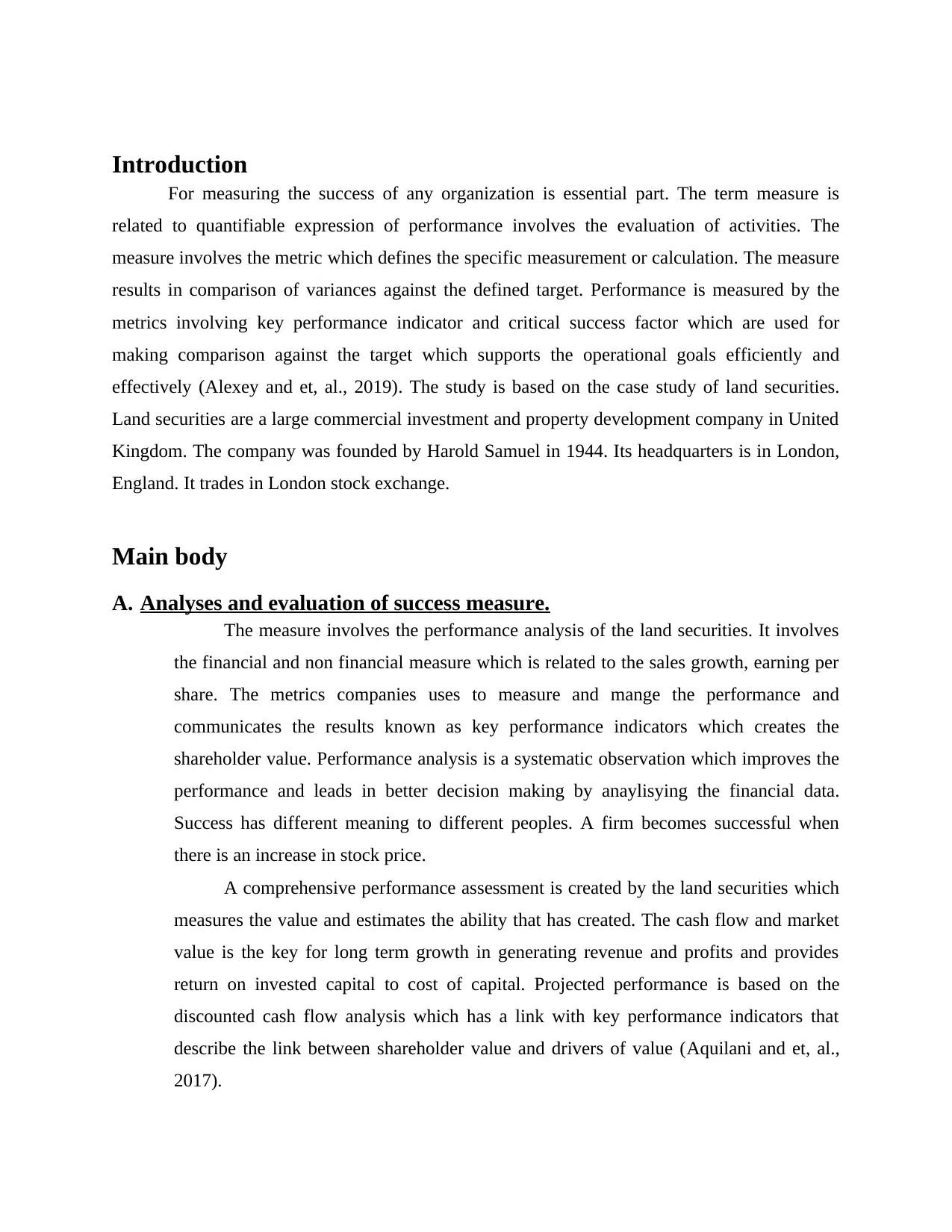
Introduction
For measuring the success of any organization is essential part. The term measure is
related to quantifiable expression of performance involves the evaluation of activities. The
measure involves the metric which defines the specific measurement or calculation. The measure
results in comparison of variances against the defined target. Performance is measured by the
metrics involving key performance indicator and critical success factor which are used for
making comparison against the target which supports the operational goals efficiently and
effectively (Alexey and et, al., 2019). The study is based on the case study of land securities.
Land securities are a large commercial investment and property development company in United
Kingdom. The company was founded by Harold Samuel in 1944. Its headquarters is in London,
England. It trades in London stock exchange.
Main body
A. Analyses and evaluation of success measure.
The measure involves the performance analysis of the land securities. It involves
the financial and non financial measure which is related to the sales growth, earning per
share. The metrics companies uses to measure and mange the performance and
communicates the results known as key performance indicators which creates the
shareholder value. Performance analysis is a systematic observation which improves the
performance and leads in better decision making by anaylisying the financial data.
Success has different meaning to different peoples. A firm becomes successful when
there is an increase in stock price.
A comprehensive performance assessment is created by the land securities which
measures the value and estimates the ability that has created. The cash flow and market
value is the key for long term growth in generating revenue and profits and provides
return on invested capital to cost of capital. Projected performance is based on the
discounted cash flow analysis which has a link with key performance indicators that
describe the link between shareholder value and drivers of value (Aquilani and et, al.,
2017).
For measuring the success of any organization is essential part. The term measure is
related to quantifiable expression of performance involves the evaluation of activities. The
measure involves the metric which defines the specific measurement or calculation. The measure
results in comparison of variances against the defined target. Performance is measured by the
metrics involving key performance indicator and critical success factor which are used for
making comparison against the target which supports the operational goals efficiently and
effectively (Alexey and et, al., 2019). The study is based on the case study of land securities.
Land securities are a large commercial investment and property development company in United
Kingdom. The company was founded by Harold Samuel in 1944. Its headquarters is in London,
England. It trades in London stock exchange.
Main body
A. Analyses and evaluation of success measure.
The measure involves the performance analysis of the land securities. It involves
the financial and non financial measure which is related to the sales growth, earning per
share. The metrics companies uses to measure and mange the performance and
communicates the results known as key performance indicators which creates the
shareholder value. Performance analysis is a systematic observation which improves the
performance and leads in better decision making by anaylisying the financial data.
Success has different meaning to different peoples. A firm becomes successful when
there is an increase in stock price.
A comprehensive performance assessment is created by the land securities which
measures the value and estimates the ability that has created. The cash flow and market
value is the key for long term growth in generating revenue and profits and provides
return on invested capital to cost of capital. Projected performance is based on the
discounted cash flow analysis which has a link with key performance indicators that
describe the link between shareholder value and drivers of value (Aquilani and et, al.,
2017).
⊘ This is a preview!⊘
Do you want full access?
Subscribe today to unlock all pages.

Trusted by 1+ million students worldwide
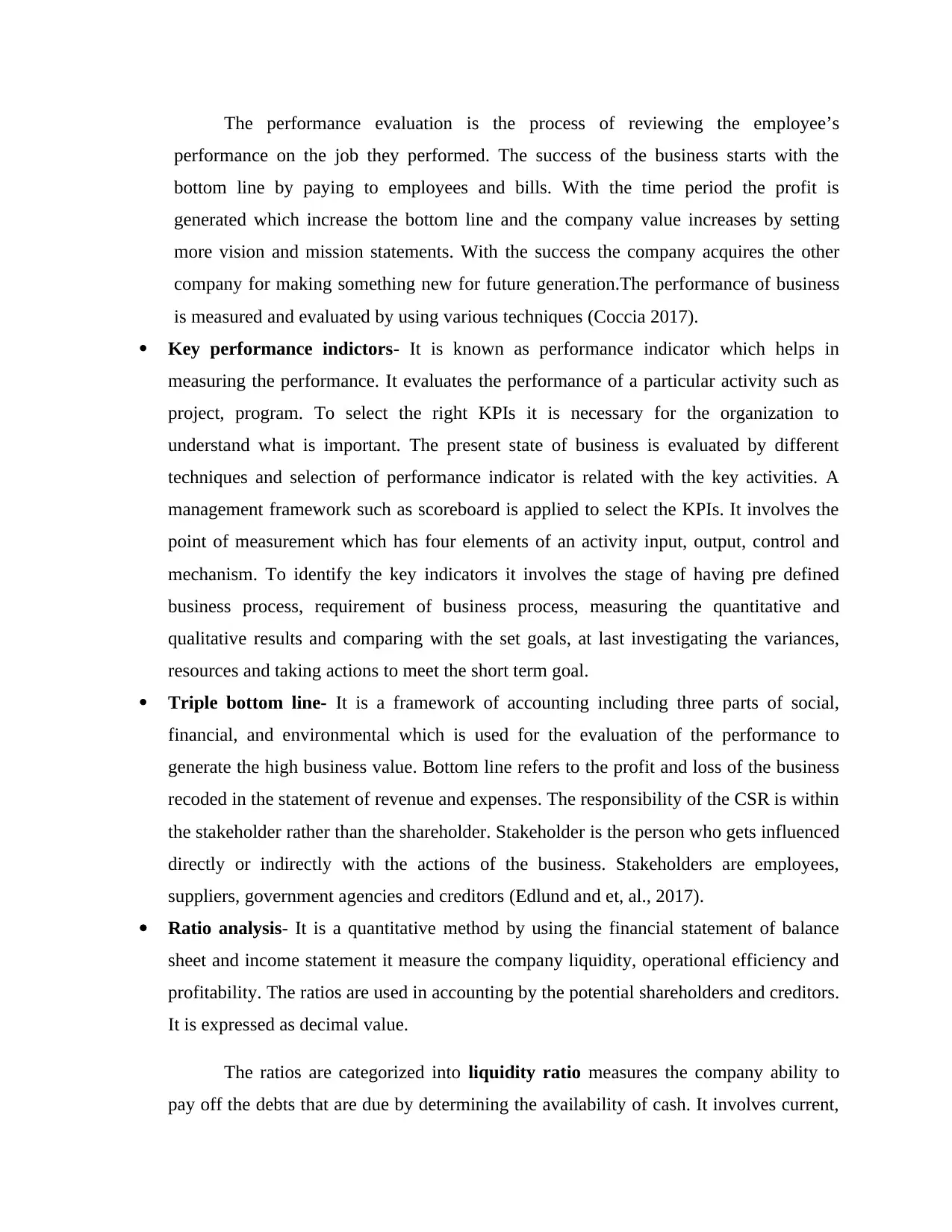
The performance evaluation is the process of reviewing the employee’s
performance on the job they performed. The success of the business starts with the
bottom line by paying to employees and bills. With the time period the profit is
generated which increase the bottom line and the company value increases by setting
more vision and mission statements. With the success the company acquires the other
company for making something new for future generation.The performance of business
is measured and evaluated by using various techniques (Coccia 2017).
Key performance indictors- It is known as performance indicator which helps in
measuring the performance. It evaluates the performance of a particular activity such as
project, program. To select the right KPIs it is necessary for the organization to
understand what is important. The present state of business is evaluated by different
techniques and selection of performance indicator is related with the key activities. A
management framework such as scoreboard is applied to select the KPIs. It involves the
point of measurement which has four elements of an activity input, output, control and
mechanism. To identify the key indicators it involves the stage of having pre defined
business process, requirement of business process, measuring the quantitative and
qualitative results and comparing with the set goals, at last investigating the variances,
resources and taking actions to meet the short term goal.
Triple bottom line- It is a framework of accounting including three parts of social,
financial, and environmental which is used for the evaluation of the performance to
generate the high business value. Bottom line refers to the profit and loss of the business
recoded in the statement of revenue and expenses. The responsibility of the CSR is within
the stakeholder rather than the shareholder. Stakeholder is the person who gets influenced
directly or indirectly with the actions of the business. Stakeholders are employees,
suppliers, government agencies and creditors (Edlund and et, al., 2017).
Ratio analysis- It is a quantitative method by using the financial statement of balance
sheet and income statement it measure the company liquidity, operational efficiency and
profitability. The ratios are used in accounting by the potential shareholders and creditors.
It is expressed as decimal value.
The ratios are categorized into liquidity ratio measures the company ability to
pay off the debts that are due by determining the availability of cash. It involves current,
performance on the job they performed. The success of the business starts with the
bottom line by paying to employees and bills. With the time period the profit is
generated which increase the bottom line and the company value increases by setting
more vision and mission statements. With the success the company acquires the other
company for making something new for future generation.The performance of business
is measured and evaluated by using various techniques (Coccia 2017).
Key performance indictors- It is known as performance indicator which helps in
measuring the performance. It evaluates the performance of a particular activity such as
project, program. To select the right KPIs it is necessary for the organization to
understand what is important. The present state of business is evaluated by different
techniques and selection of performance indicator is related with the key activities. A
management framework such as scoreboard is applied to select the KPIs. It involves the
point of measurement which has four elements of an activity input, output, control and
mechanism. To identify the key indicators it involves the stage of having pre defined
business process, requirement of business process, measuring the quantitative and
qualitative results and comparing with the set goals, at last investigating the variances,
resources and taking actions to meet the short term goal.
Triple bottom line- It is a framework of accounting including three parts of social,
financial, and environmental which is used for the evaluation of the performance to
generate the high business value. Bottom line refers to the profit and loss of the business
recoded in the statement of revenue and expenses. The responsibility of the CSR is within
the stakeholder rather than the shareholder. Stakeholder is the person who gets influenced
directly or indirectly with the actions of the business. Stakeholders are employees,
suppliers, government agencies and creditors (Edlund and et, al., 2017).
Ratio analysis- It is a quantitative method by using the financial statement of balance
sheet and income statement it measure the company liquidity, operational efficiency and
profitability. The ratios are used in accounting by the potential shareholders and creditors.
It is expressed as decimal value.
The ratios are categorized into liquidity ratio measures the company ability to
pay off the debts that are due by determining the availability of cash. It involves current,
Paraphrase This Document
Need a fresh take? Get an instant paraphrase of this document with our AI Paraphraser
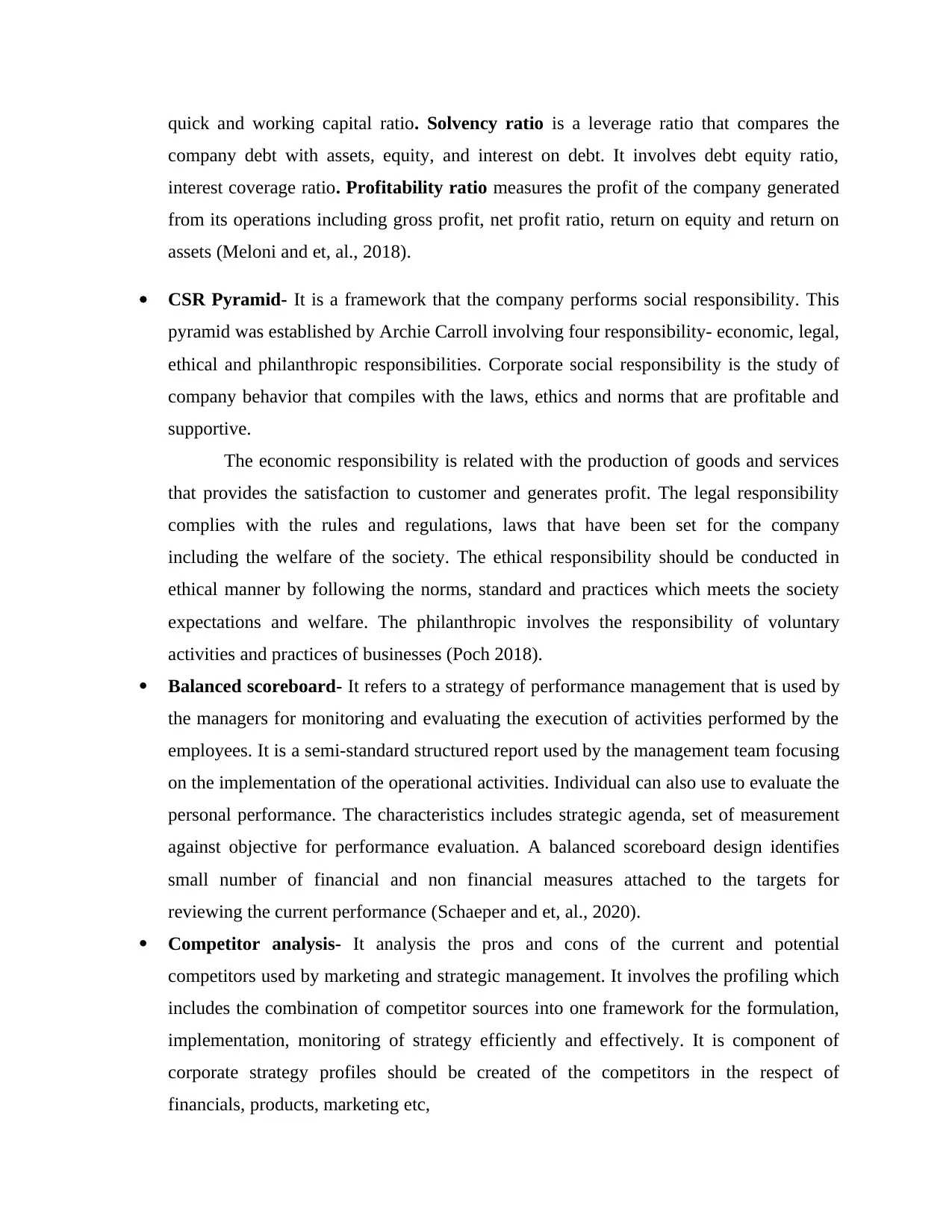
quick and working capital ratio. Solvency ratio is a leverage ratio that compares the
company debt with assets, equity, and interest on debt. It involves debt equity ratio,
interest coverage ratio. Profitability ratio measures the profit of the company generated
from its operations including gross profit, net profit ratio, return on equity and return on
assets (Meloni and et, al., 2018).
CSR Pyramid- It is a framework that the company performs social responsibility. This
pyramid was established by Archie Carroll involving four responsibility- economic, legal,
ethical and philanthropic responsibilities. Corporate social responsibility is the study of
company behavior that compiles with the laws, ethics and norms that are profitable and
supportive.
The economic responsibility is related with the production of goods and services
that provides the satisfaction to customer and generates profit. The legal responsibility
complies with the rules and regulations, laws that have been set for the company
including the welfare of the society. The ethical responsibility should be conducted in
ethical manner by following the norms, standard and practices which meets the society
expectations and welfare. The philanthropic involves the responsibility of voluntary
activities and practices of businesses (Poch 2018).
Balanced scoreboard- It refers to a strategy of performance management that is used by
the managers for monitoring and evaluating the execution of activities performed by the
employees. It is a semi-standard structured report used by the management team focusing
on the implementation of the operational activities. Individual can also use to evaluate the
personal performance. The characteristics includes strategic agenda, set of measurement
against objective for performance evaluation. A balanced scoreboard design identifies
small number of financial and non financial measures attached to the targets for
reviewing the current performance (Schaeper and et, al., 2020).
Competitor analysis- It analysis the pros and cons of the current and potential
competitors used by marketing and strategic management. It involves the profiling which
includes the combination of competitor sources into one framework for the formulation,
implementation, monitoring of strategy efficiently and effectively. It is component of
corporate strategy profiles should be created of the competitors in the respect of
financials, products, marketing etc,
company debt with assets, equity, and interest on debt. It involves debt equity ratio,
interest coverage ratio. Profitability ratio measures the profit of the company generated
from its operations including gross profit, net profit ratio, return on equity and return on
assets (Meloni and et, al., 2018).
CSR Pyramid- It is a framework that the company performs social responsibility. This
pyramid was established by Archie Carroll involving four responsibility- economic, legal,
ethical and philanthropic responsibilities. Corporate social responsibility is the study of
company behavior that compiles with the laws, ethics and norms that are profitable and
supportive.
The economic responsibility is related with the production of goods and services
that provides the satisfaction to customer and generates profit. The legal responsibility
complies with the rules and regulations, laws that have been set for the company
including the welfare of the society. The ethical responsibility should be conducted in
ethical manner by following the norms, standard and practices which meets the society
expectations and welfare. The philanthropic involves the responsibility of voluntary
activities and practices of businesses (Poch 2018).
Balanced scoreboard- It refers to a strategy of performance management that is used by
the managers for monitoring and evaluating the execution of activities performed by the
employees. It is a semi-standard structured report used by the management team focusing
on the implementation of the operational activities. Individual can also use to evaluate the
personal performance. The characteristics includes strategic agenda, set of measurement
against objective for performance evaluation. A balanced scoreboard design identifies
small number of financial and non financial measures attached to the targets for
reviewing the current performance (Schaeper and et, al., 2020).
Competitor analysis- It analysis the pros and cons of the current and potential
competitors used by marketing and strategic management. It involves the profiling which
includes the combination of competitor sources into one framework for the formulation,
implementation, monitoring of strategy efficiently and effectively. It is component of
corporate strategy profiles should be created of the competitors in the respect of
financials, products, marketing etc,
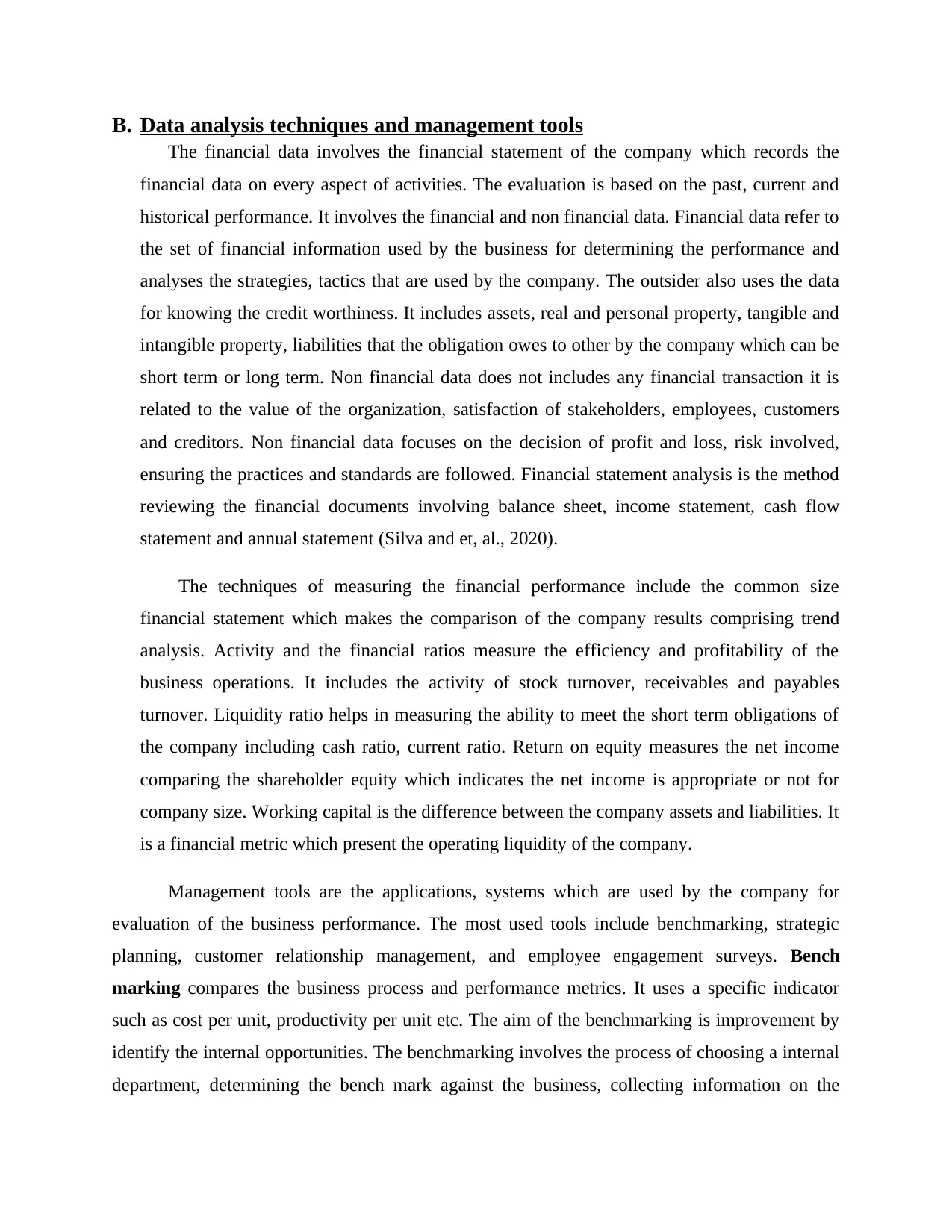
B. Data analysis techniques and management tools
The financial data involves the financial statement of the company which records the
financial data on every aspect of activities. The evaluation is based on the past, current and
historical performance. It involves the financial and non financial data. Financial data refer to
the set of financial information used by the business for determining the performance and
analyses the strategies, tactics that are used by the company. The outsider also uses the data
for knowing the credit worthiness. It includes assets, real and personal property, tangible and
intangible property, liabilities that the obligation owes to other by the company which can be
short term or long term. Non financial data does not includes any financial transaction it is
related to the value of the organization, satisfaction of stakeholders, employees, customers
and creditors. Non financial data focuses on the decision of profit and loss, risk involved,
ensuring the practices and standards are followed. Financial statement analysis is the method
reviewing the financial documents involving balance sheet, income statement, cash flow
statement and annual statement (Silva and et, al., 2020).
The techniques of measuring the financial performance include the common size
financial statement which makes the comparison of the company results comprising trend
analysis. Activity and the financial ratios measure the efficiency and profitability of the
business operations. It includes the activity of stock turnover, receivables and payables
turnover. Liquidity ratio helps in measuring the ability to meet the short term obligations of
the company including cash ratio, current ratio. Return on equity measures the net income
comparing the shareholder equity which indicates the net income is appropriate or not for
company size. Working capital is the difference between the company assets and liabilities. It
is a financial metric which present the operating liquidity of the company.
Management tools are the applications, systems which are used by the company for
evaluation of the business performance. The most used tools include benchmarking, strategic
planning, customer relationship management, and employee engagement surveys. Bench
marking compares the business process and performance metrics. It uses a specific indicator
such as cost per unit, productivity per unit etc. The aim of the benchmarking is improvement by
identify the internal opportunities. The benchmarking involves the process of choosing a internal
department, determining the bench mark against the business, collecting information on the
The financial data involves the financial statement of the company which records the
financial data on every aspect of activities. The evaluation is based on the past, current and
historical performance. It involves the financial and non financial data. Financial data refer to
the set of financial information used by the business for determining the performance and
analyses the strategies, tactics that are used by the company. The outsider also uses the data
for knowing the credit worthiness. It includes assets, real and personal property, tangible and
intangible property, liabilities that the obligation owes to other by the company which can be
short term or long term. Non financial data does not includes any financial transaction it is
related to the value of the organization, satisfaction of stakeholders, employees, customers
and creditors. Non financial data focuses on the decision of profit and loss, risk involved,
ensuring the practices and standards are followed. Financial statement analysis is the method
reviewing the financial documents involving balance sheet, income statement, cash flow
statement and annual statement (Silva and et, al., 2020).
The techniques of measuring the financial performance include the common size
financial statement which makes the comparison of the company results comprising trend
analysis. Activity and the financial ratios measure the efficiency and profitability of the
business operations. It includes the activity of stock turnover, receivables and payables
turnover. Liquidity ratio helps in measuring the ability to meet the short term obligations of
the company including cash ratio, current ratio. Return on equity measures the net income
comparing the shareholder equity which indicates the net income is appropriate or not for
company size. Working capital is the difference between the company assets and liabilities. It
is a financial metric which present the operating liquidity of the company.
Management tools are the applications, systems which are used by the company for
evaluation of the business performance. The most used tools include benchmarking, strategic
planning, customer relationship management, and employee engagement surveys. Bench
marking compares the business process and performance metrics. It uses a specific indicator
such as cost per unit, productivity per unit etc. The aim of the benchmarking is improvement by
identify the internal opportunities. The benchmarking involves the process of choosing a internal
department, determining the bench mark against the business, collecting information on the
⊘ This is a preview!⊘
Do you want full access?
Subscribe today to unlock all pages.

Trusted by 1+ million students worldwide
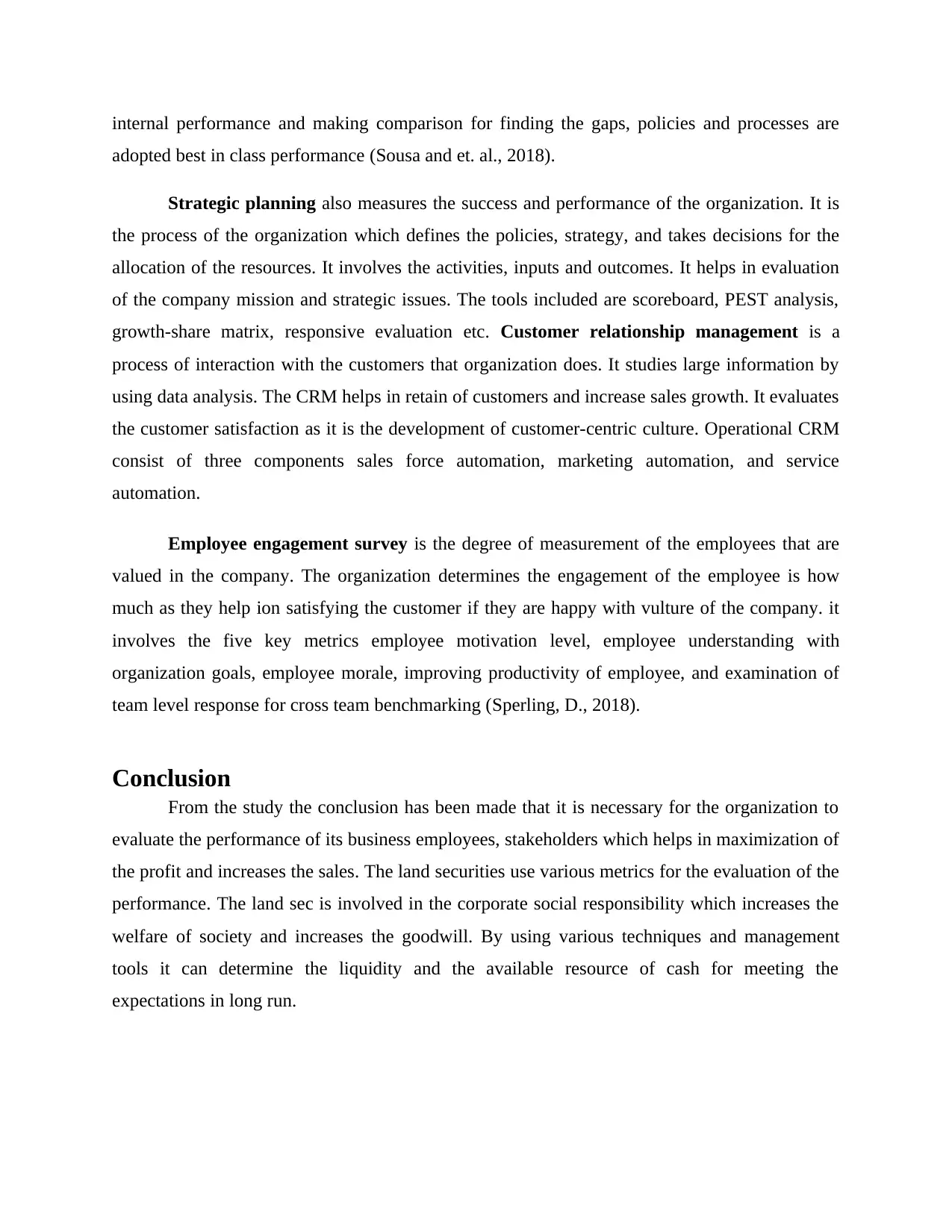
internal performance and making comparison for finding the gaps, policies and processes are
adopted best in class performance (Sousa and et. al., 2018).
Strategic planning also measures the success and performance of the organization. It is
the process of the organization which defines the policies, strategy, and takes decisions for the
allocation of the resources. It involves the activities, inputs and outcomes. It helps in evaluation
of the company mission and strategic issues. The tools included are scoreboard, PEST analysis,
growth-share matrix, responsive evaluation etc. Customer relationship management is a
process of interaction with the customers that organization does. It studies large information by
using data analysis. The CRM helps in retain of customers and increase sales growth. It evaluates
the customer satisfaction as it is the development of customer-centric culture. Operational CRM
consist of three components sales force automation, marketing automation, and service
automation.
Employee engagement survey is the degree of measurement of the employees that are
valued in the company. The organization determines the engagement of the employee is how
much as they help ion satisfying the customer if they are happy with vulture of the company. it
involves the five key metrics employee motivation level, employee understanding with
organization goals, employee morale, improving productivity of employee, and examination of
team level response for cross team benchmarking (Sperling, D., 2018).
Conclusion
From the study the conclusion has been made that it is necessary for the organization to
evaluate the performance of its business employees, stakeholders which helps in maximization of
the profit and increases the sales. The land securities use various metrics for the evaluation of the
performance. The land sec is involved in the corporate social responsibility which increases the
welfare of society and increases the goodwill. By using various techniques and management
tools it can determine the liquidity and the available resource of cash for meeting the
expectations in long run.
adopted best in class performance (Sousa and et. al., 2018).
Strategic planning also measures the success and performance of the organization. It is
the process of the organization which defines the policies, strategy, and takes decisions for the
allocation of the resources. It involves the activities, inputs and outcomes. It helps in evaluation
of the company mission and strategic issues. The tools included are scoreboard, PEST analysis,
growth-share matrix, responsive evaluation etc. Customer relationship management is a
process of interaction with the customers that organization does. It studies large information by
using data analysis. The CRM helps in retain of customers and increase sales growth. It evaluates
the customer satisfaction as it is the development of customer-centric culture. Operational CRM
consist of three components sales force automation, marketing automation, and service
automation.
Employee engagement survey is the degree of measurement of the employees that are
valued in the company. The organization determines the engagement of the employee is how
much as they help ion satisfying the customer if they are happy with vulture of the company. it
involves the five key metrics employee motivation level, employee understanding with
organization goals, employee morale, improving productivity of employee, and examination of
team level response for cross team benchmarking (Sperling, D., 2018).
Conclusion
From the study the conclusion has been made that it is necessary for the organization to
evaluate the performance of its business employees, stakeholders which helps in maximization of
the profit and increases the sales. The land securities use various metrics for the evaluation of the
performance. The land sec is involved in the corporate social responsibility which increases the
welfare of society and increases the goodwill. By using various techniques and management
tools it can determine the liquidity and the available resource of cash for meeting the
expectations in long run.
Paraphrase This Document
Need a fresh take? Get an instant paraphrase of this document with our AI Paraphraser
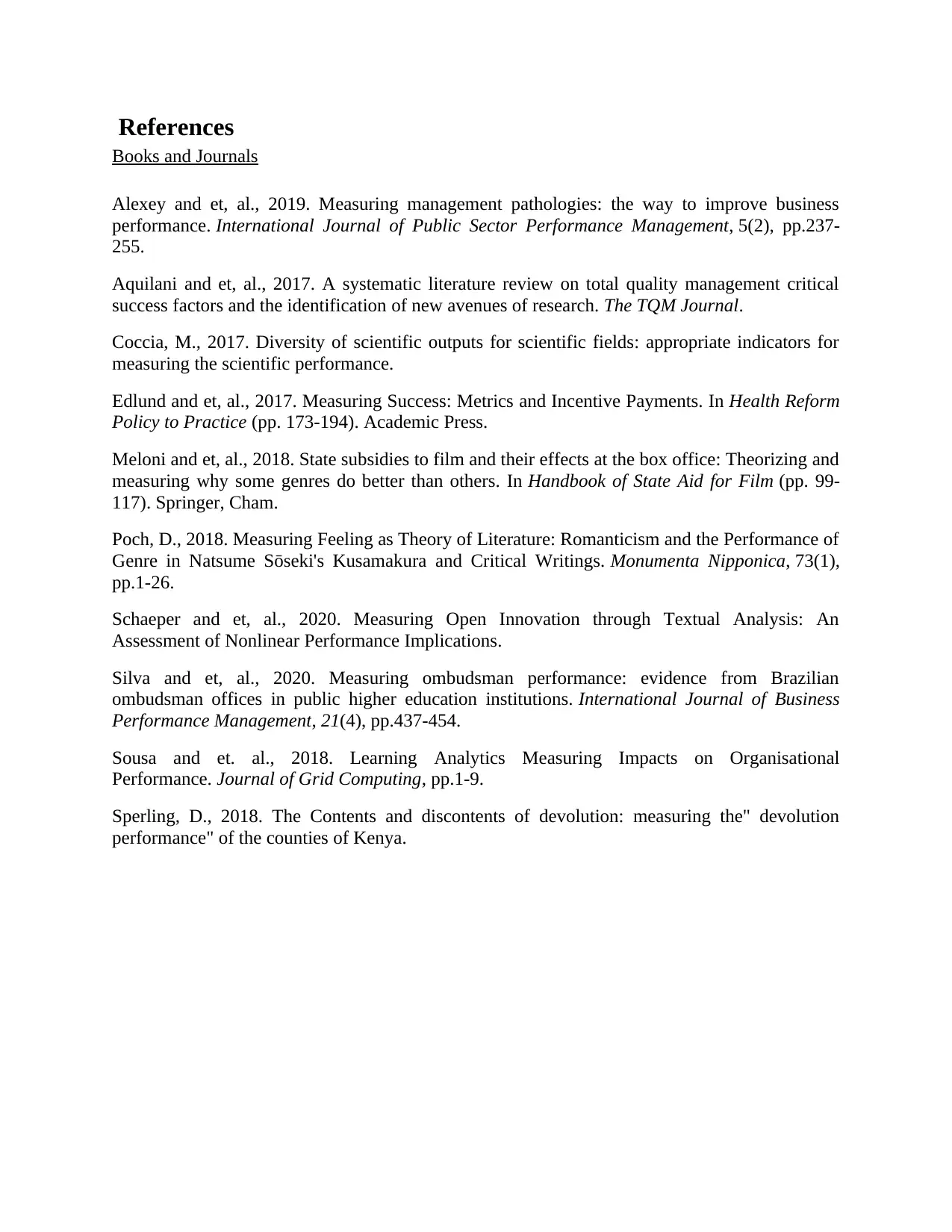
References
Books and Journals
Alexey and et, al., 2019. Measuring management pathologies: the way to improve business
performance. International Journal of Public Sector Performance Management, 5(2), pp.237-
255.
Aquilani and et, al., 2017. A systematic literature review on total quality management critical
success factors and the identification of new avenues of research. The TQM Journal.
Coccia, M., 2017. Diversity of scientific outputs for scientific fields: appropriate indicators for
measuring the scientific performance.
Edlund and et, al., 2017. Measuring Success: Metrics and Incentive Payments. In Health Reform
Policy to Practice (pp. 173-194). Academic Press.
Meloni and et, al., 2018. State subsidies to film and their effects at the box office: Theorizing and
measuring why some genres do better than others. In Handbook of State Aid for Film (pp. 99-
117). Springer, Cham.
Poch, D., 2018. Measuring Feeling as Theory of Literature: Romanticism and the Performance of
Genre in Natsume Sōseki's Kusamakura and Critical Writings. Monumenta Nipponica, 73(1),
pp.1-26.
Schaeper and et, al., 2020. Measuring Open Innovation through Textual Analysis: An
Assessment of Nonlinear Performance Implications.
Silva and et, al., 2020. Measuring ombudsman performance: evidence from Brazilian
ombudsman offices in public higher education institutions. International Journal of Business
Performance Management, 21(4), pp.437-454.
Sousa and et. al., 2018. Learning Analytics Measuring Impacts on Organisational
Performance. Journal of Grid Computing, pp.1-9.
Sperling, D., 2018. The Contents and discontents of devolution: measuring the" devolution
performance" of the counties of Kenya.
Books and Journals
Alexey and et, al., 2019. Measuring management pathologies: the way to improve business
performance. International Journal of Public Sector Performance Management, 5(2), pp.237-
255.
Aquilani and et, al., 2017. A systematic literature review on total quality management critical
success factors and the identification of new avenues of research. The TQM Journal.
Coccia, M., 2017. Diversity of scientific outputs for scientific fields: appropriate indicators for
measuring the scientific performance.
Edlund and et, al., 2017. Measuring Success: Metrics and Incentive Payments. In Health Reform
Policy to Practice (pp. 173-194). Academic Press.
Meloni and et, al., 2018. State subsidies to film and their effects at the box office: Theorizing and
measuring why some genres do better than others. In Handbook of State Aid for Film (pp. 99-
117). Springer, Cham.
Poch, D., 2018. Measuring Feeling as Theory of Literature: Romanticism and the Performance of
Genre in Natsume Sōseki's Kusamakura and Critical Writings. Monumenta Nipponica, 73(1),
pp.1-26.
Schaeper and et, al., 2020. Measuring Open Innovation through Textual Analysis: An
Assessment of Nonlinear Performance Implications.
Silva and et, al., 2020. Measuring ombudsman performance: evidence from Brazilian
ombudsman offices in public higher education institutions. International Journal of Business
Performance Management, 21(4), pp.437-454.
Sousa and et. al., 2018. Learning Analytics Measuring Impacts on Organisational
Performance. Journal of Grid Computing, pp.1-9.
Sperling, D., 2018. The Contents and discontents of devolution: measuring the" devolution
performance" of the counties of Kenya.
1 out of 8
Related Documents
Your All-in-One AI-Powered Toolkit for Academic Success.
+13062052269
info@desklib.com
Available 24*7 on WhatsApp / Email
![[object Object]](/_next/static/media/star-bottom.7253800d.svg)
Unlock your academic potential
Copyright © 2020–2025 A2Z Services. All Rights Reserved. Developed and managed by ZUCOL.





